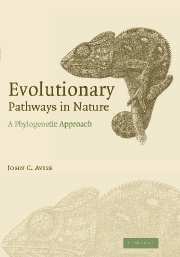Book contents
- Frontmatter
- Contents
- Preface
- Acknowledgments
- 1 Introduction
- 2 Anatomical structures and morphologies
- 3 Body colorations
- 4 Sexual features and reproductive lifestyles
- 5 More behaviors and ecologies
- 6 Cellular, physiological, and genetic traits
- 7 Geographical distributions
- Epilog
- Appendix: a primer on phylogenetic character mapping
- Glossary
- References and further reading
- Index
5 - More behaviors and ecologies
Published online by Cambridge University Press: 18 December 2009
- Frontmatter
- Contents
- Preface
- Acknowledgments
- 1 Introduction
- 2 Anatomical structures and morphologies
- 3 Body colorations
- 4 Sexual features and reproductive lifestyles
- 5 More behaviors and ecologies
- 6 Cellular, physiological, and genetic traits
- 7 Geographical distributions
- Epilog
- Appendix: a primer on phylogenetic character mapping
- Glossary
- References and further reading
- Index
Summary
The behaviors of organisms evolve just as surely as do their physical features. Indeed, the connections between a species' behavioral repertoire and its suite of morphological attributes are almost always so tight as to blur distinctions between organismal form and function, i.e. between what a creature is and what it does. Adaptive co-evolution between a species' behavioral ecology and its physical attributes accounts for why we don't observe, for example, vegetarian leopards or predatory antelopes.
As presaged in Chapter 4, PCM analyses can be conducted on behavioral and lifestyle traits just as they can on morphological ones. This chapter will provide several additional examples ranging from evolutionary analyses of the kangaroo's bipedal hop to the organization of multi-species lizard communities on Caribbean islands, and from how pufferfish gained the ability to inflate their bodies into anti-predation balls to how particular bacteria sense the earth's geomagnetic field. In most of the following case studies, PCM analyses have been applied as well to anatomical attributes associated with particular organismal behaviors, meaning that the topics explored in this chapter will also overlap to some degree with those covered in Chapter 2.
The kangaroo's bipedal hop
When in fast gait, kangaroos and their relatives (family Macropodidae) employ the bipedal hop. Indeed, two-legged hopping is mandatory for rapid cross-country locomotion because these animals' forelimbs are short and weak whereas their long hindlimbs are powerfully constructed for propulsion.
- Type
- Chapter
- Information
- Evolutionary Pathways in NatureA Phylogenetic Approach, pp. 114 - 152Publisher: Cambridge University PressPrint publication year: 2006



